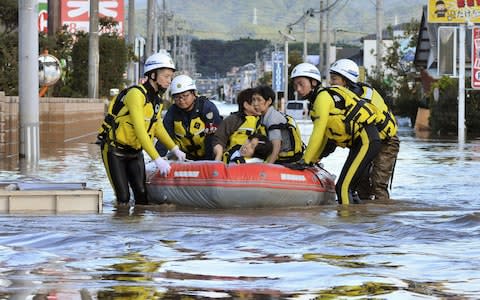Typhoon Hagibis: Army deployed on rescue missions as death toll rises to 30

Tens of thousands of troops were deployed on rescue missions across Japan on Sunday after a powerful typhoon caused widespread flooding and landslides, leaving at least 30 people dead and 15 missing.
Tokyo was brought to standstill ahead of the arrival of Super Typhoon Hagibis – the most powerful storm to hit Japan in decades – which made landfall at around 7pm on Saturday evening in Shizuoka Prefecture, just south of the capital.
More than six million people were advised to evacuate across central and eastern Japan, with record-breaking rainfall and gusts of wind of up to 134 mph triggering burst rivers, flooding, mudslides and black outs.
The powerful storm continued northwards along the eastern coast – an area badly hit in the 2011 earthquake, tsunami and nuclear crisis – before reportedly triggering 11 leak alerts at Fukushima Daiichi nuclear power plant.
As the capital awoke to blue post-storm skies on Sunday morning, many rain and flood warnings had been lifted but 376,000 homes had no electricity and 14,000 lacked running water, according to government officials.

Helicopters, boats and 27,000 troops and rescue workers were deployed by the government in a major operation to assist those stranded in flooded homes across the country, including Nagano Prefecture, one of the worst hit areas.
Speaking after an emergency meeting, Shinzo Abe, the prime minister, offered support and condolences to those impacted by the disaster, adding: “With respect to blackouts, water outage and suspension of transportation services, we will do our utmost to bring about a swift recovery. We ask the public to stay vigilant in case of landslides and other hazards.”
Officials had earlier warned that the storm could be the most powerful to hit Japan since 1958, when one of the worst typhoons on record devastated Tokyo and surrounding areas, killing more than 1,200 people.
As the storm approached Japan on Saturday, Yasushi Kajiwara, a forecaster at Japan's Meteorological Agency, told media: “Unprecedented heavy rain has been seen in cities, towns and villages for which the emergency warning was issued. The possibility is extremely high that disasters such as landslides and floods have already occurred. It is important to take action that can help save your lives."

With dramatic timing, a magnitude 5.7 earthquake also struck off the coast of Chiba – and was felt in Tokyo – shortly before the storm’s arrival, although there were no injuries or tsunami warnings.
Before the typhoon made landfall, a 50-year-old man was killed after his car was overturned in strong winds in Chiba Prefecture, an area east of Tokyo badly damaged in a separate typhoon which hit last month.
At least two people were killed when landslides hit homes in Fukushima and Gunma, while a man was also reportedly found dead in his flooded apartment in Kawasaki.
A cargo ship from Panama with 12 people on board also sunk in Tokyo Bay where it was anchored on Saturday night, according to Kyodo News. Five crew members died and three more remain missing.
There were also reports that a woman in her 70s died after she was accidentally dropped 131 feet to the ground while being transported into a rescue helicopter in Iwaki City, Fukushima Prefecture.

More than 15 were still missing on Sunday, many swept away in floodwaters, and over 100 were reportedly injured, according to public broadcaster NHK.
The storm triggered record rainfall in various locations across Japan, including the popular hot spring resort Hakone, near Mount Fuji, just outside Tokyo, which was deluged with 27 inches of rain over 24 hours.
Among those who evacuated ahead of its arrival was Yuka Ikemura, 24, a nursery school teacher who sought refuge at a community centre in east Tokyo with her son, three, eight-month-old baby daughter and pet rabbit.
“I’ve got small children to take care of and we live on the first floor of an old apartment,” she told Reuters. “We brought with us the bare necessities. I’m scared to think about when we will have run out diapers and milk.”
The storm caused chaos to the Rugby World Cup schedule, with England v France among several cancelled games, while the Formula One Grand Prix in Suzuka also faced disruption but was due to go ahead later on Sunday.

 Yahoo News
Yahoo News 
